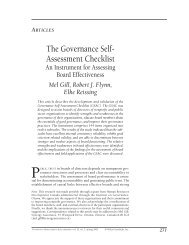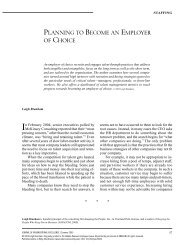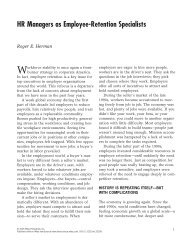The final gift: targeting the potential charity legator
The final gift: targeting the potential charity legator
The final gift: targeting the potential charity legator
You also want an ePaper? Increase the reach of your titles
YUMPU automatically turns print PDFs into web optimized ePapers that Google loves.
Targeting <strong>the</strong> <strong>potential</strong> <strong>charity</strong> <strong>legator</strong> 5<br />
McGranahan (2000: 1289) posits that <strong>the</strong><br />
documentary evidence also suggests that:<br />
‘In <strong>the</strong> case of wills, individuals give to<br />
<strong>charity</strong> in order to influence how <strong>the</strong>y will<br />
be remembered. <strong>The</strong> notion that individuals<br />
give in part to influence how <strong>the</strong>y will<br />
be perceived also corresponds well with <strong>the</strong><br />
public nature of many charitable <strong>gift</strong>s and<br />
<strong>the</strong> lack of anonymity in giving.’<br />
No fur<strong>the</strong>r literature pertaining to <strong>the</strong> profile of<br />
<strong>legator</strong>s or <strong>the</strong>ir motives for offering such<br />
support could be identified. However, extensive<br />
empirical data are available in respect of<br />
<strong>the</strong> profile of <strong>charity</strong> donors and <strong>the</strong>ir motives<br />
for supporting charities during <strong>the</strong>ir lifetime.<br />
This study combined this knowledge with that<br />
gained from focus groups, to develop a<br />
measurement instrument that enabled <strong>the</strong><br />
profile and motives of those pledging a legacy<br />
to be compared quantitatively with o<strong>the</strong>r<br />
categories of supporter.<br />
Methodology<br />
A two-stage methodology was adopted in<br />
partnership with five major national UK<br />
charities representing a variety of different<br />
categories of cause. In <strong>the</strong> preliminary stage<br />
focus groups were conducted with legacy<br />
pledgers from each participant organization.<br />
<strong>The</strong> aim of <strong>the</strong> focus groups was to elicit <strong>the</strong><br />
motives of donors for becoming legacy pledgers<br />
to <strong>the</strong> participant organization and to<br />
derive a series of factors that could <strong>the</strong>n be<br />
tested quantitatively in <strong>the</strong> second stage. As <strong>the</strong><br />
reader will appreciate, many of <strong>the</strong> factors to<br />
emerge from focus group discussions reflected<br />
extant <strong>the</strong>mes in <strong>the</strong> wider giving behaviour<br />
literature. We thus integrated pertinent literature<br />
in our discussion below. Each group ran<br />
for around 90 minutes and discussions were<br />
taped, transcribed and subjected to a content<br />
analysis employing QSR NUD*IST. This analysis<br />
suggested that three distinct categories of<br />
factor should be considered, namely:<br />
(1) specific legacy motives<br />
(2) individual factors<br />
(3) organizational factors.<br />
<strong>The</strong> model being suggested here is illustrated in<br />
Figure 1. Each key category will now be<br />
discussed in turn. Selected quotations from <strong>the</strong><br />
focus groups are offered for illustrative purposes<br />
ra<strong>the</strong>r than in a scientific manner.<br />
Organizational factors<br />
Performance<br />
<strong>The</strong> extent to which nonprofit organizations<br />
are seen to be effective in fulfiling <strong>the</strong>ir mission<br />
is widely regarded as a critical contributory<br />
Figure 1.<br />
Focus Group Model.<br />
Copyright # 2005 John Wiley & Sons, Ltd. Int. J. Nonprofit Volunt. Sect. Mark., February 2005







